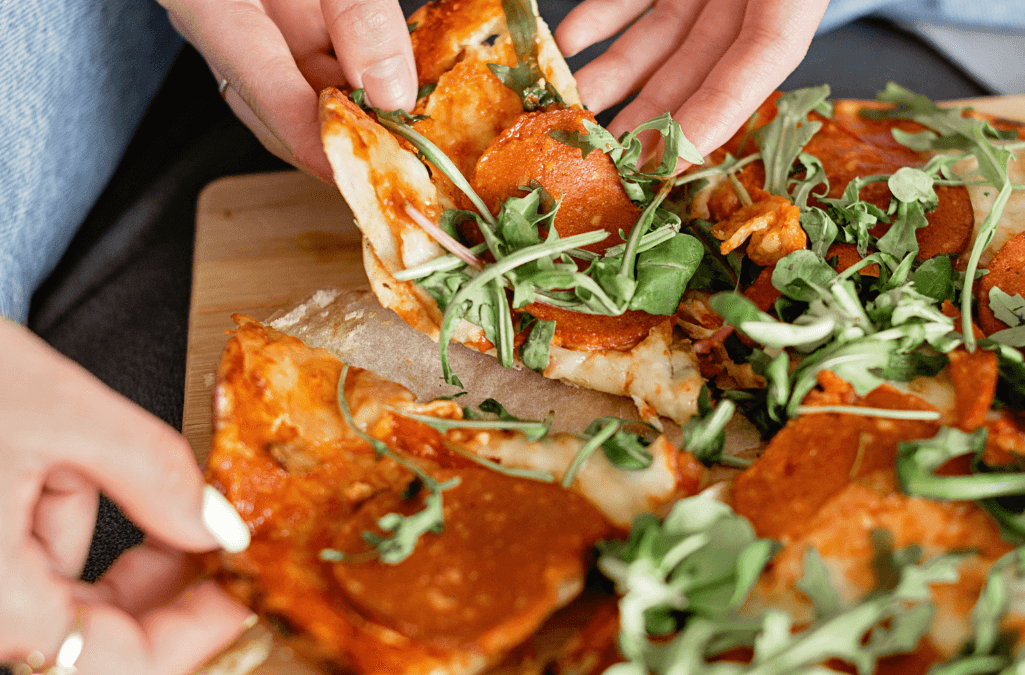
The history of pizza is a long and fascinating one, dating back thousands of years. Its origins can be traced back to ancient civilizations in the Mediterranean, where flatbreads with toppings were a common meal. However, modern pizza, as we know it today, was invented in Naples, Italy, in the 18th century.
Today, pizza is enjoyed all over the globe and has become a staple for parties, gatherings and indulgent nights in. With countless pizza variations, including deep-dish, thin-crust and stuffed crust, and a wide range of toppings, it's easy to understand why this tasty and versatile dish has become one of the most popular food choices in the world.
learn More About The Origins of Pizza
Before the creation of pizza, there were flatbreads.
These were garnished with various toppings, much like what we see on pizzas, and were a popular dish in ancient times. The Greeks made flatbreads topped with herbs, oil and cheese, whilst the Egyptians baked them and then topped them with herbs, vegetables and sometimes meats.
But this simple recipe was the beginning of what would evolve into the pizza we recognize today.
It is believed that the first pizzas were created by poor farmers in Italy who would add tomatoes to their flatbreads, along with cheese, and bake them in wood-fired ovens. Tomatoes were a relatively new ingredient in Italy at the time, having been brought back from the Americas by explorers in the 16th century.
This creation was then sold on the streets and eaten by the working class as an inexpensive yet satisfying meal.
Pizza Evolved
Over time, other toppings, such as basil and olive oil, were added, which produced what is known today as the classic Margherita pizza.
Although this has become one of the most popular types of pizza on the market, it was originally created in 1889 in honor of Queen Margherita of Savoy. The ingredients were selected to represent each Italian flag colour - tomatoes for the red, basil for the green and mozzarella cheese formed the white section.
Pizza is now a significant part of Italian culture, with the government even promoting it as a symbol of Italian national identity in the early 20th century. This has helped cement its place in Italian cuisine whilst also being enjoyed throughout the rest of the world.
How Pizza Gained Popularity in America
In the late 19th and early 20th centuries, Italian immigrants brought pizza to the United States, with the first pizzeria opening in New York City in 1905. Soon, other pizzerias followed, and by the 1930s, pizza had become popular among Italian immigrants in cities like New York, Chicago and Philadelphia.
During World War II, pizza became more widely known among non-Italian Americans once soldiers stationed in Italy tried the dish for the first time and thoroughly enjoyed it. Consequently, after the war, returning soldiers helped to increase the popularity of pizza across the United States, and, by the 1960s, it had become a staple food in many American households.
It has even been updated and customized by Americans who have developed regional styles, such as Chicago deep-dish pizza.
The adaptability of pizza has allowed it to become a favorite in other countries and cultures, too, since toppings can be tailored to suit local tastes and ingredients. For example, in Korea, you might find pizza topped with kimchi, while kebab meat is not uncommon in the Middle East.
However, Italian and American-style pizzas remain the most well-known and are enjoyed by people across the globe, with some even travelling to Italy or certain states to taste authentic regional pizza.
This love of pizza has only been solidified by the rise of fast-food chains, which have helped push pizza's global reach and appeal with exciting new variations and flavors.

The Rise of Artisanal Pizza
The rise of artisanal pizza dates back to the 1980s and 1990s when a new generation of chefs began to take a more creative approach to pizza-making. Rather than simply offering traditional toppings on a standard crust, these chefs experimented with different doughs, sauces and toppings and developed new techniques for baking and serving this beloved dish.
Artisanal pizza is typically characterized by its high-quality ingredients, hand-crafted doughs and experimental toppings. One example would be a crust made with organic flour, topped with homemade tomato sauce, fresh mozzarella cheese, locally-grown vegetables and hand-cured meats like pancetta.
Many artisanal pizzerias also use wood-fired ovens to cook their pizzas, giving the crust a distinctive charred flavor and crisp texture.
One of the most influential figures in the rise of artisanal pizza was chef Chris Bianco who opened Pizzeria Bianco in Phoenix, Arizona, in 1988. Bianco's pizza was a departure from the traditional American-style pizza because it had a thin, crispy crust and simple, high-quality toppings.
Pizzeria Bianco quickly became a destination for food lovers from around the country and helped inspire a new wave of artisanal pizzerias.
Today, artisanal pizza is a popular and growing trend in the food industry, with many pizzerias offering unique and innovative pizzas that reflect local flavors and ingredients.
In addition to wood-fired pizzas, many artisanal pizzerias also offer gluten-free and vegan options to cater to the increasing number of plant-based diets and the wide range of dietary preferences in modern society.
Innovations and Trends in Pizza
Pizza has evolved massively over time, mainly due to introducing of new toppings and combinations to reflect changing tastes and culinary trends.
While traditional toppings, like tomato sauce, mozzarella cheese and pepperoni, remain commonplace, more unique and creative toppings have gained popularity over the last few decades.
One of the earliest examples of this was Hawaiian pizza, created in Canada in the 1960s. Hawaiian pizza features a ham and pineapple topping, which is enjoyed by many - though frowned upon by some - thanks to its exciting blend of sweet and savory flavors.
There have since been other popular additions to the pizza topping options, including chicken, barbecue sauce, bacon, mushrooms and onions.

Pizzas have become adventurous.
In recent years, the trend has shifted towards more adventurous and unconventional toppings like figs, goat cheese, truffle oil, and curry. Vegan toppings, like plant-based meat substitutes and vegan cheese, are also becoming more widely available.
In addition to new toppings, some pizzerias also experiment with different types of crusts, sauces and cooking methods. For example, some now offer gluten-free cauliflower crusts, while others use alternatives like pesto or white sauce instead of the traditional tomato sauce.
Wood-fired ovens, once a hallmark of artisanal pizzerias, are now used by many mainstream pizzerias to give their pizzas a distinctive flavor and texture.
We also must recognize the role of technology when discussing the evolution of, and innovations in, the pizza industry. It has significantly impacted how pizzas are ordered, made and delivered, with the most apparent being online ordering.
Pizza is Super Accessible.
Many pizzerias and restaurants now allow customers to order their pizza through websites or mobile apps, allowing for even further customization and the ease of enjoying a pizza without leaving the house.
Technology has also affected the way pizzas are made. Some pizzerias now use automated pizza-making machines that can press the dough, add toppings and bake pizzas in one device. These machines can help to speed up the pizza-making process and improve consistency in quality.
Overall, technology has helped to make the pizza industry more efficient, convenient, and accessible to customers while also providing new opportunities for innovation and growth.
What does the future of the pizza industry look like?
Pizza's future will likely involve continued innovation and evolution, with new trends, techniques and technologies shaping how we make, order, and enjoy pizza.
One major trend that we are sure will continue to grow is artisanal and speciality pizza. As consumers become more interested in high-quality, unique, locally-sourced ingredients, pizzerias will likely focus on offering more inventive and bespoke pizzas that cater to these expanding tastes.
Another changing consumer preference that will play a massive role in shaping the future of the pizza industry is the increased demand for plant-based options.
As more people adopt vegan or vegetarian diets and alternative food lifestyles, pizzerias will find they need to offer more pizzas in that realm.
Technology will only advance further over the coming years without telling what that will do to the pizza industry. Delivery services will become even quicker and more reliable, automated machinery will ensure pizza quality is at its highest across taste and appearance, and access to well-made pizza will be more accessible than ever.
There is no doubt that no matter what the pizza industry looks like in years to come, this popular and delicious food is going nowhere.
Are you on the hunt for the best pizza in Redding, California? Look no further than Pete's Brewhouse!
Our award-winning pizza recipe will leave your taste buds in a state of pure bliss, and you'll be aching for more after just one bite.
At Pete's Brewhouse, we take pizza seriously. We use only the freshest ingredients, including homemade dough and house-made red sauce, and we top our pies with high-quality, mouth-watering toppings that will leave you wanting more.
So why settle for mediocre pizza when you can have the best? Come on down to Pete's Brewhouse in Redding, California for your next pizza night. Trust us, you won't be disappointed.
At Pete's Pizza Redding, we believe good pizza starts with the best toppings.
We start with homemade dough prepared daily and hand-tossed in the classic New York style. We then add our house-made red sauce, whole-milk mozzarella, and your choice of high-quality toppings to create a flavor explosion that's sure to make your taste buds dance with joy.
When it comes to pizza in Redding, there's no competition - we've got the best. And we serve it hot and fresh, seven days a week. We believe that classic pizza is an art form that should never be messed with, and once you've tried ours, you'll never settle for anything less.
So, if you're in the mood for a delicious meal and searching for pizza places in redding ca, look no further than our classic pizza that's been perfected over the years. Look no further than Pete's Classic Pizza. We guarantee you won't be disappointed.
But that's not all - we also offer a wide range of delicious food options beyond pizza, including juicy burgers, fresh salads, flavorful pasta dishes, satisfying sandwiches, and our signature brews.
VIEW OUR MENU
No matter what you're in the mood for, Pete's Brewhouse is the perfect spot for a hearty meal, a refreshing drink, or a night out with friends in The lively town of Redding, California.
At Pete's Pizza Redding, we take our motto, "Life's too short for bad pizza," seriously. That's why our award-winning pizza recipe has remained the same for over 30 years. We use only the freshest ingredients, including the homemade dough and house-made red sauce, to create the perfect pizza every time.
So what are you waiting for? Come experience the best pizza in Redding at Pete's Pizza Redding. Your taste buds will thank you!
All rights reserved 2021. Site by Khamu Solutions